Our Collections officer, Pam Keeton kindly agreed to write this fascinating insight into the unseen work that happens in order to care properly for our Collections.
She writes
As the final stages of the recent restoration of Cliffe Castle’s staircase stained glass window neared completion, it became necessary to close the museum to the public after New Year and reopen on Friday 18th January 2019. This period of time was far from quiet for the staff though, in fact a hive of activity was going on behind the closed doors.
We took the opportunity to engage in some focused housekeeping and conservation cleaning tasks that are difficult to do during normal opening hours and we would like to share how we went about it.
Why would you…..?
Basic housekeeping is an essential part of collection care and a museums preventive conservation plan. It underpins how we care for our historic interiors and collections both on display and in storage. This is done by maintaining the fabric of the building, monitoring and controlling the environment: the relative humidity, light and possible pest infestation. The collections are the museums prime resource and are what makes Cliffe Castle unique and so well loved.
It’s the seemingly humble activity of dusting that is one of the most important elements of the housekeeping routine. Dust is a perennial museum problem and keeping accumulated dust under control but without compromising the condition of the object by well-intentioned over-cleaning is money in the bank. Not only does a build-up of dust and dirt look unattractive and surfaces neglected, it has some potentially serious side effects for historic artefacts.
Dust is made up of minute inorganic and organic particles of grit, soot, environmental pollutants, skin, textile and plant fibres, pollen and the general debris from everyday life. A layer of dust is hygroscopic, that is, it begins to absorb and hold moisture from the environment. This combination can contribute to corrosion on metals and encourage and sustain mould growth. Long standing or poorly removed dust can also become compacted and cemented to a surface resulting in textured finishes, carving and crevices having a dull grey appearance. Cementation can be very difficult and time consuming for a conservator to remove and endangers the objects surface and patina.
Dusty nooks and crannies can also create foodstuff and harbourage for insects. Some of these insects can become a foodstuff in turn for larger pests or, more worryingly, their grubby young might turn their ravenous attentions on the collection. Anything organic from textiles, fur, feather, leather, wood and paper is under threat from woodworm, carpet beetle, clothes moth, silverfish…to name but a few. We monitor for insect infestation but the best prevention is by observation and disturbance tactics of regular vacuuming – particularly edges, corners and the difficult to reach bits. A lot of collection care involves being on your hands and knees, laying on the floor looking under furniture or up step ladders.
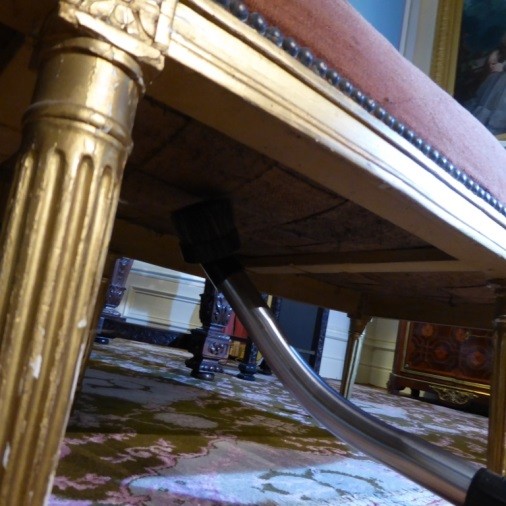
Suck it up……
Conservation cleaning and repairs are based on minimum intervention, sympathetic treatments and reversibility wherever possible. Cleaning is irreversible and only done if it’s necessary, not because of an imposed routine as this will cause unnecessary wear such as gilding being worn away from a frame. We always start with the gentlest methods first and in most cases this means using a soft brush to flick the dust away from the surface and a vacuum cleaner to capture it so it’s not redistributed. We often use museum backpack vacuum cleaners that have variable suction and HEPA filters.
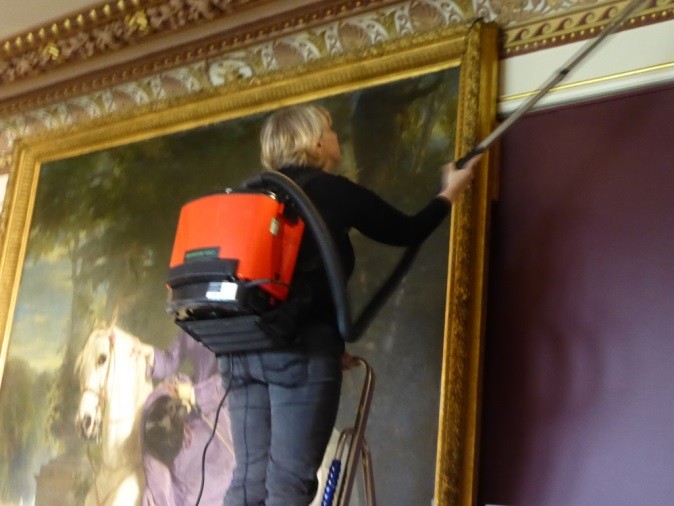
Cleaning cloths need to be smooth and lint free and are only used on smooth surfaces to avoid snagging and causing damage, for example to the edges of veneered and inlayed furniture.
Ordinary domestic cleaning products are usually unsuitable for delicate and historic objects and interiors because they often contain additives that can cause serious and irreversible deterioration.
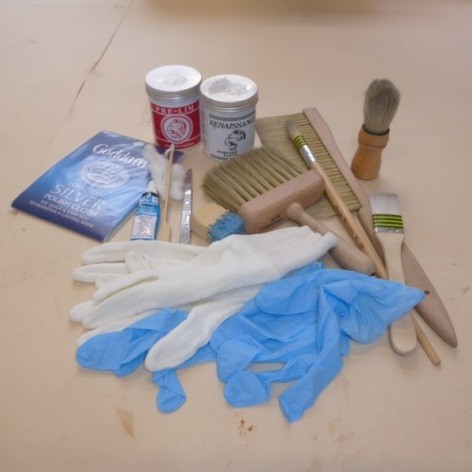
We use conservation grade detergents, cleaning agents and waxes that are mild and will not exacerbate deterioration. Selecting and applying an appropriate treatment requires background knowledge of different types of materials, how they deteriorate and how to arrest damage and improve condition appropriately.
Back in the day…….
In the past, household cleaning recipes were often a closely guarded secret and kept in the mistress or housekeepers journal. Just as cookery books became popular during the 19th century, so did housekeeping manuals that extolled the virtue of cleanliness. They make very interesting reading and one can see where some of today’s products have their roots.
Bread was a common way to lift marks and stains but the residues could encourage pest activity and mould growth. Numerous types of abrasives were used to keep surfaces clean and bright such as emery and scouring papers, brick dust, pumice and rottenstone (siliceous limestone). While these would definitely clean a surface they would also be very aggressive if they were applied to more delicate finishes.
Finer powders such as fullers earth, pipe clay, whiting, alum and wood ash would be mixed with ‘sweet oil’ (olive oil) and other oils to make polishing pastes or some of them used dry to absorb stains. Ox gall, ‘aqua vitae’ (virtually pure alcohol), carbolic soap, lemon juice, vinegar and bicarbonate are just a few of the agents used for cleaning, disinfecting and brightening. Sometimes even more powerful – and often harmful – cleaning agents were employed, such as potash (a caustic alkali), heartshorn (a spirit containing ammonia) and ‘vitriol’ (sulphuric acid).
May was the traditional month for a full spring clean after the chimneys had been swept ready for the summer and housekeeping required plenty of elbow grease and time. It wasn’t until the end of the 19th century that mechanised devices started to be adopted. Mechanical carpet sweepers were soon followed by the suction vacuum cleaner. Many of these had hand or foot operated bellows that generally required more than one person and were hardly labour saving. Eventually, during the first part of the 20th century the electrical vacuum appliances we would recognise today evolved – Hurrah!
To work!
The furnished reception rooms were first to be targeted for a deep clean. The rooms are densely furnished in the high Victorian style beloved by Henry Isaac Butterfield but which makes cleaning without causing damage a very delicate, balletic operation. Therefore, we began by removing as many of the furnishings as we could.
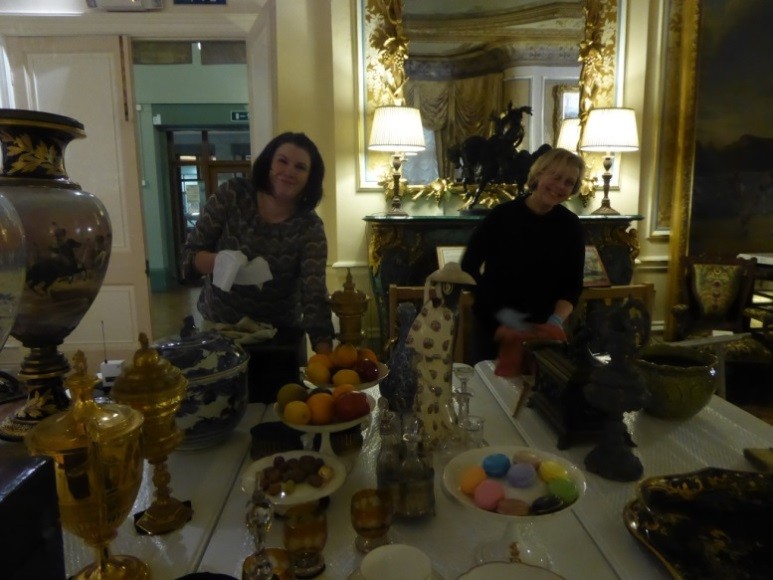
Tables with padded tops were set up in adjacent rooms to receive all of the small objects which were condition checked as they were decanted. Good handling techniques include removing or covering any rings/clothing that might scratch objects, wearing well-fitting nitrile gloves, using padded trays/trolleys to transfer the more robust objects out of the room or cradling manageable objects in both hands. Objects are never picked up by handles/knobs – just in case they aren’t as well attached as presumed! The old adage ‘to assume makes an ass of me and you (u)’ applies in these situations.
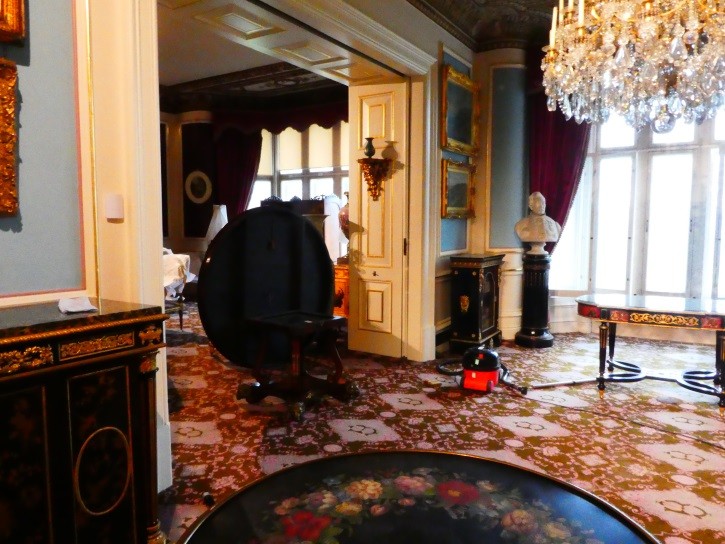
Armchairs, sofas and smaller items of furniture were removed from the room to allow the carpets to be properly inspected and vacuumed. Teams of two picked up the furniture by the most stable part: the seat rail in the case of an armchair and never by the weakest parts such as the arms or the back rail. Where casters are fitted, they are not used to push the whole weight of a piece of furniture, the bulk of the weight is lifted and the wheels are allowed to just roll along. It’s important to work steadily and methodically, improper handling and movement can cause serious and costly damage and we also need to take care of ourselves too.
All of the cornices, dado rails, sills and skirting boards were vacuumed. The drapes and blinds were lightly brushed and vacuumed on low suction with the upholstery attachment and the window glass was cleaned. Window sills are a good place to monitor for particular bugs and moths as they are drawn to the light.
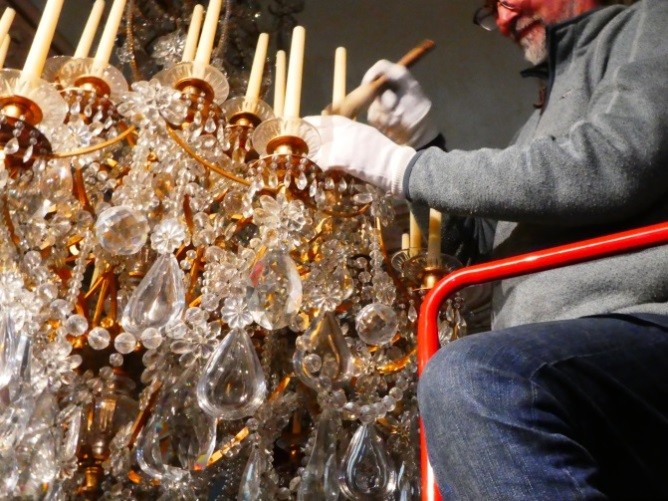
Our amazing chandeliers were gently cleaned from top to bottom using a soft brush to flick any dust into the nozzle of the backpack vacuum. The pendants and central sphere were polished by running them through cotton gloved hands. No one mentioned ‘Only Fools and Horses’ at all……..!

Textiles, upholstery and more fragile carpets and drapes were vacuumed on a very low suction through a mesh that keeps the fibres in place and reduces stress. The beaded drops on the tassels in the Great Drawing room had become buried in the threads, releasing and relaying them on the surface was only work of a moment but a strangely satisfying job.

Framed works of art and the furniture had any settled dust flicked into a vacuum cleaner with a soft brush. Some of the furniture was then wax polished with Renaissance microcrystalline wax to restore a gleam and protect the surface.
Robust glazed ceramics and stable glass first had accumulated dust removed and then cleaned with damp cotton wool swabs – they are never immersed in water which might interfere with the glaze, decoration or unseen adhesive repairs.
Metals were simply dusted and lightly Renaissance waxed and buffed. Occasionally, a swab of ethanol or a silver cleaning cloth might be used to remove light tarnish and restore a shine. The silver cleaning cloths contain a useful inhibitor that slows the corrosion process down but we are careful never to use the same cloth on different types of metals because it can start some very complicated corrosion processes off.
The decant system was then reversed and rooms reassembled….sometimes with the aid of a pre-work photograph!
The work to the staircase window and the removal of the scaffolding had resulted in an inevitable layer of dust so the wrought iron staircase balusters were painstakingly cleaned as were all of the frames, columns and tops of display cases. The Paris Exhibition clock at the bottom of the staircase had been protected by a custom made box but was now cleaned from top to bottom and the parquet floors were skillfully buffed up to a honey coloured glow.
The large paintings that hang on the staircase walls had been put into storage while the work took place were dusted both front and back. This is a rare treat for the uppermost ones because they are normally too high to safely clean. Happily everything was in good condition and had survived the experience without any remedial repairs being necessary.
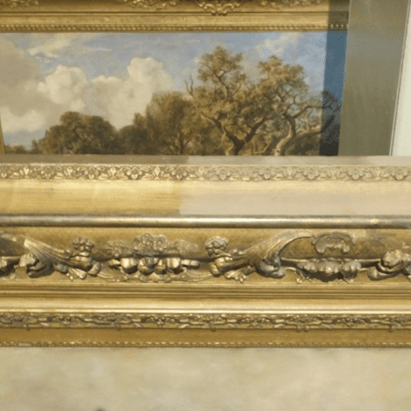
They were expertly rehung on their chains by JPA Art Services.
Spending time working so closely with beautiful, interesting objects is always a pleasure and a privilege. It allows time to properly appreciate them and understand their construction and intricacies. The other pleasure came from working with a great team of people who really applied themselves to getting the long list of tasks completed to a high standard.